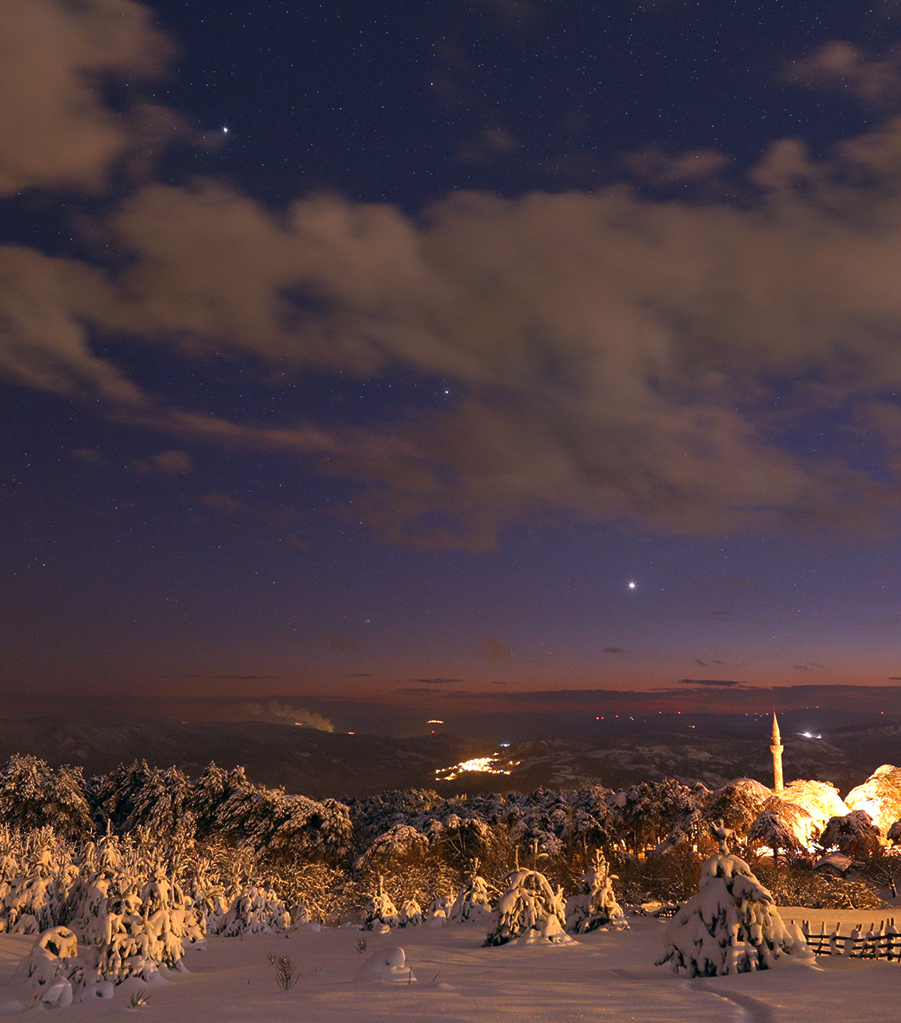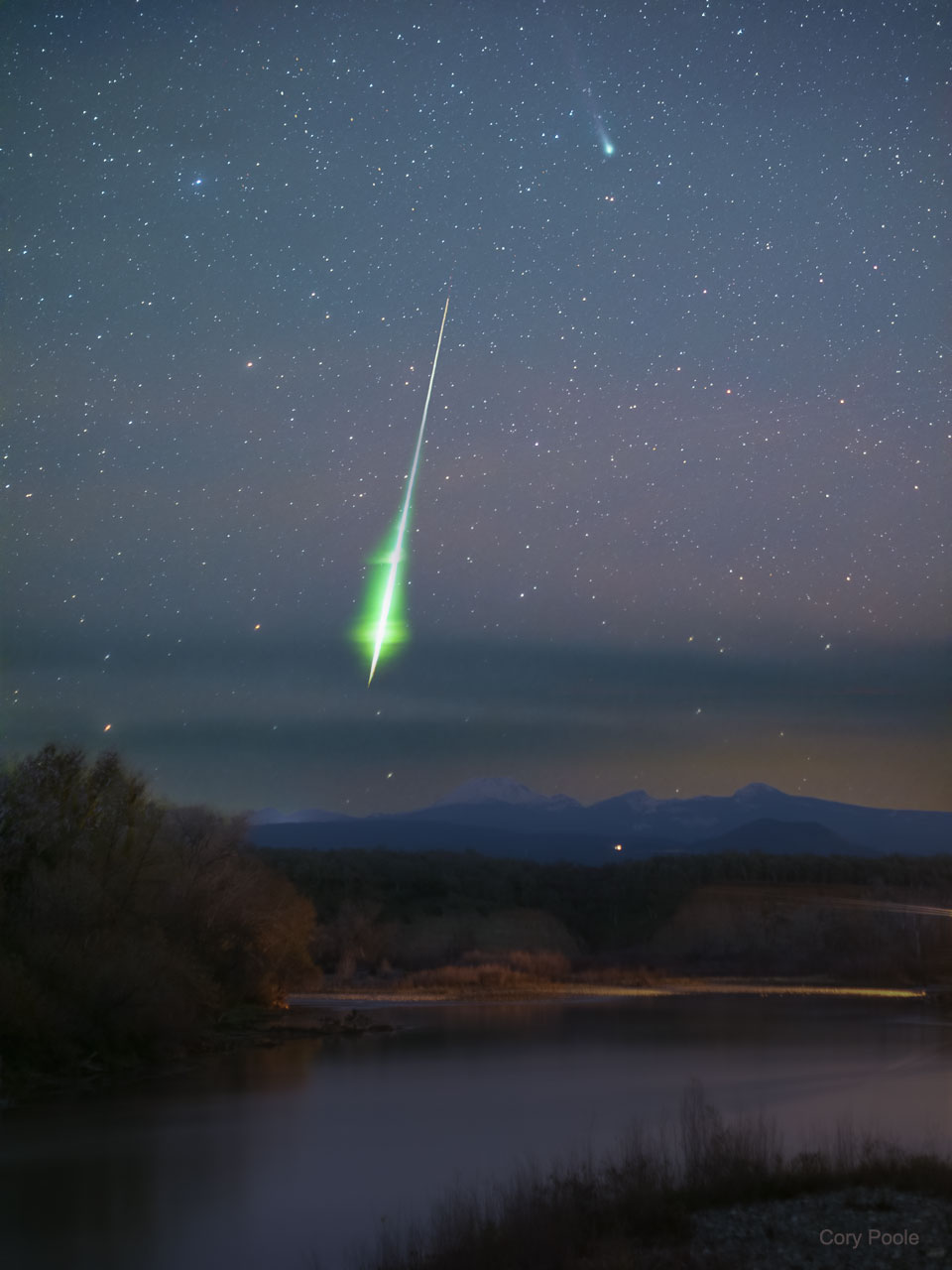
Nombre total de pages vues
25/12/2021
AERONAUTIQUE - Avions de légende - Le Boeing B-29 Superfortress

23/12/2021
ASTRONOMY - Three Planets and a Comet
2021 December 23
Image Credit & Copyright: Tunc Tezel (TWAN)
Explanation: Are you still looking for that perfect holiday gift for an astronomer? If your night sky is dark and horizon clear enough, the Solar System may have done your shopping for you. Send them outside after sunset to see three planets and a comet. In this snapshot of the December solstice evening sky from the village of Kirazli, Turkey the brightest celestial beacon is Venus, close to the southwestern horizon at the right. Look left and up to find Saturn shining between clouds. Follow that line farther left and up to bright Jupiter, the Solar System's ruling gas giant. This year's surprise visitor to the inner Solar System, Comet Leonard (C/2021 A1), is near the horizon too. The comet is fainter but forms a nearly equilateral triangle with planets Venus and Saturn in this view. After a dramatic brightening in recent days the comet is just visible to the unaided eye, though a nice pair of binoculars is always a good idea.
22/12/2021
ASTRONOMY - Launch of the IXPE Observatory
2021 December 22
Image Credit & Copyright: Jordan Sirokie
Explanation: Birds don't fly this high. Airplanes don't go this fast. The Statue of Liberty weighs less. No species other than human can even comprehend what is going on, nor could any human just a millennium ago. The launch of a rocket bound for space is an event that inspires awe and challenges description. Pictured here, a SpaceX Falcon 9 rocket lifted off from Kennedy Space Center, Florida earlier this month carrying the Imaging X-ray Polarimetry Explorer (IXPE). IXPE is scheduled to observe high-energy objects such as neutron stars, black holes, and the centers of distant galaxies to better determine the physics and geometries that create and control them. From a standing start, the 300,000+ kilogram rocket ship lifted IXPE up to circle the Earth, where the outside air is too thin to breathe. Rockets bound for space are now launched from somewhere on Earth every few days.
21/12/2021
ASTRONOMY - Solstice Sun and Milky Way
2021 December 21
Composite Image Credit & Copyright: Stefan Seip (TWAN)
Explanation: Welcome to December's solstice, first day of winter in the north and summer for the southern hemisphere. Astronomical markers of the seasons, solstice and equinox dates are based on the Sun's place in its annual journey along the ecliptic, through planet Earth's sky. At this solstice, the Sun reaches its maximum southern declination of -23.5 degrees today at 15:59 UTC, while its right ascension coordinate on the celestial sphere is 18 hours. That puts the Sun in the constellation Sagittarius in a direction near the center of our Milky Way galaxy. In fact, if you could see today's Solstice Sun against faint background stars and nebulae (that's really hard to do, especially in the daytime ...) your view might look something like this composited panorama. To make it, images of our fair galaxy were taken under dark Namibian night skies, then stitched together in a panoramic view. From a snapshot made on 2015 December 21, the Sun was digitally overlayed as a brilliant star at today's northern winter solstice position, close to the center of the Milky Way.
SOLSTICES - Le solstice d'hiver est aujourd'hui à 16 h 59 !
SCIENCE - Minéraux - L’anglésite, une pierre de plomb
20/12/2021
ASTRONOMY - The Comet and the Fireball
2021 December 20
Image Credit & Copyright: Cory Poole
Explanation: This picture was supposed to feature a comet. Specifically, a series of images of the brightest comet of 2021 were being captured: Comet Leonard. But the universe had other plans. Within a fraction of a second, a meteor so bright it could be called a fireball streaked through just below the comet. And the meteor's flash was even more green than the comet's coma. The cause of the meteor's green was likely magnesium evaporating from the meteor's pebble-sized core, while the cause of the comet's green was likely diatomic carbon recently ejected from the comet's city-sized nucleus. The images were taken 10 days ago over the Sacramento River and Mt. Lassen in California, USA. The fireball was on the leading edge of this year's Geminid Meteor Shower -- which peaked a few days later. Comet Leonard is now fading after reaching naked-eye visibility last week -- but now is moving into southern skies.
19/12/2021
ASTRONOMY - Planetary Alignment over Italy
2021 December 19
Image Credit & Copyright: Antonio Finazzi
Explanation: It is not a coincidence that planets line up. That's because all of the planets orbit the Sun in (nearly) a single sheet called the plane of the ecliptic. When viewed from inside that plane -- as Earth dwellers are likely to do -- the planets all appear confined to a single band. It is a coincidence, though, when three of the brightest planets all appear in nearly the same direction. Such a coincidence was captured earlier this month. Featured above (right to left), Venus, Saturn, and Jupiter were all imaged together in a line just after sunset, from the San Fermo Hills, Bergamo, Italy. Joining the alignment are Earth's Moon, and the position of the more distant Uranus. Bands of clouds streak across the sky toward the setting Sun. As Comet Leonard fades, this planetary alignment -- absent the Moon -- should persist for the rest of the month.
AERONAUTIQUE - Avions de légende - Le Spirit of St. Louis (l'avion de Charles Lindbergh)
 |
ASTRONOMIE - Bénou - Équivalent à 22 bombes atomiques
Des chercheurs ont déterminé la date précise à laquelle un astéroïde pourrait potentiellement percuter la Terre, criant dans cette collision...

-
2022 September 26 All the Water on Planet Earth Illustration Credit: Jack Cook, Adam Nieman, Woods Hole Oceanographic Institution ; Data ...
-
2021 August 11 Mammatus Clouds over Saskatchewan Image Credit & Copyright: Michael F Johnston Explanation: When do cloud bottoms appe...






